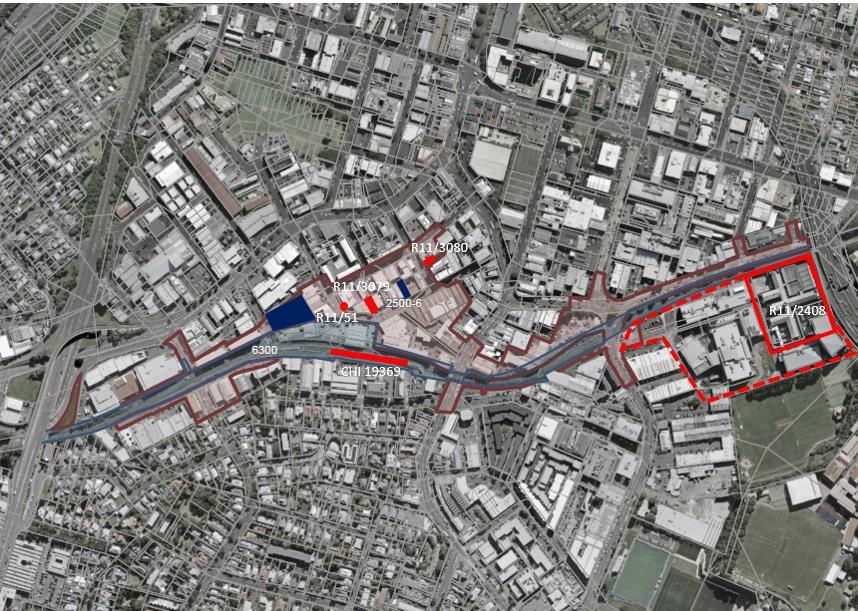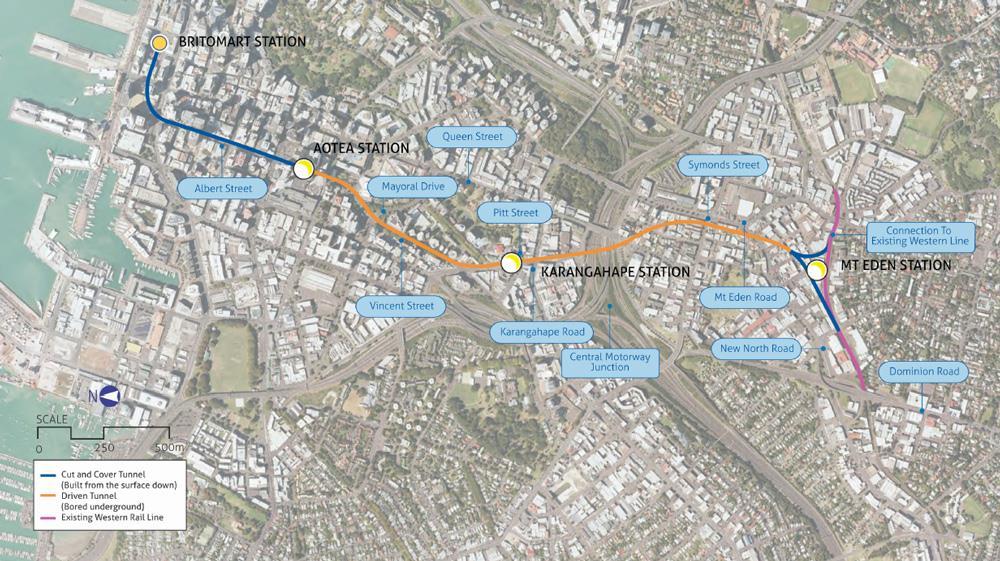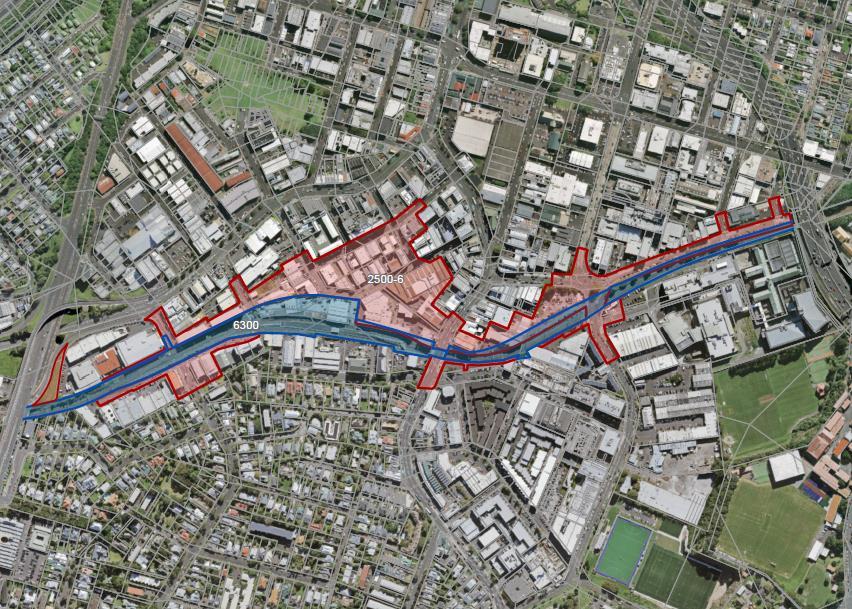
11 minute read
6. Archaeological Procedures and Mitigation Measures
6.1 Mt Eden Railway Station Platform
During demolition of the existing NAL Mt Eden railway station platform, the Project Archaeologist (or other qualified archaeologist under their direction) will record a section through the platform and details of the original 1912 platform construction beneath the surface of the current platform.
6.2 Archaeological Discovery Protocols
As noted in Section 3.1, there is only limited potential for subsurface archaeological remains to be exposed during the main works. However, the possibility that archaeological features and deposits may be exposed during construction will be managed and mitigated by call-in of the Project Archaeologist by the construction team; the recording of any remains exposed; and the recovery of samples of archaeological material for further analysis.
If suspected archaeological remains (of pre-1900 or early 20 th
century date) are encountered, works will stop in the immediate vicinity of the find until the Project Archaeologist (or other qualified archaeologist acting under their direction) can assess the site.
6.3 Management of Archaeological or Cultural Remains
Once in situ archaeological features or deposits (of pre-1900 or early 20 th century date) have been
confirmed, the Project Archaeologist will
advise the relevant Project Manager and works will not resume in the immediate area until the necessary archaeological investigation and recording has been completed. The Project Archaeologist (or other qualified archaeologist acting under their direction) will investigate and record the remains, in accordance with accepted archaeological practice as set out in Sections 6.5 to 6.9 of this HC DWP (Archaeology Section) and the requirements of the HNZPT Authority.
If remains indicating Māori occupation or kōiwi tangata (human remains) are exposed, the protocols outlined in Section 6.4 of this HC DWP (Archaeology Section) will be followed.
If significant archaeological features or deposits are identified during the main works, the Auckland Council (Cultural Heritage Implementation Team Leader and Compliance Monitoring Officer), HNZPT and mana whenua will first be notified by the Project Archaeologist, and the remains will then be investigated and recorded in accordance with accepted archaeological practice and as directed by HNZPT, if of pre-1900 date. Any significant remains of 20th century date will also be investigated and recorded as directed by the Auckland Council Cultural Heritage Implementation Team Leader.
6.4 Mana Whenua Protocols
6.4.1. Archaeological Remains
If archaeological remains relating to Māori occupation are exposed, the Project Archaeologist will inform the appropriate mana whenua representatives, HNZPT and Auckland Council (Compliance Monitoring Officer and Cultural Heritage Implementation Team Leader).
6.4.2. Kōiwi Tangata (Human Remains)
If bone material is identified that could potentially be human, the following protocol will be adopted:
Page 16
Mt Eden Main Works
Earthworks/investigation will cease in the immediate vicinity while the Project Archaeologist (or other approved archaeologist) establishes whether the bone is human; If it is not clear whether the bone is human, work shall cease in the immediate vicinity until the Auckland University reference collection and/or a specialist can be consulted and a definite identification made; If bone is confirmed as human (kōiwi tangata), the Project Archaeologist will immediately contact the mana whenua representatives, HNZPT, the NZ Police Auckland Central crime squad and Auckland Council Cultural Heritage Implementation Team Leader and Compliance Monitoring Officer; The site will be secured in a way that protects the kōiwi as far as possible from further damage; Once the NZ Police and HNZPT are satisfied that the remains are archaeological, consultation will be undertaken between the mana whenua representatives, the HNZPT Regional Archaeologist, the Auckland Council Cultural Heritage Implementation Team and City Rail Link Limited (CRLL) to determine and advise the most appropriate course of action. No further action will be taken until responses have been received from all parties, and the kōiwi will not be removed until advised by HNZPT; The Mana Whenua representatives will advise on appropriate tikanga and be given the opportunity to conduct any cultural ceremonies that are appropriate; If the Mana Whenua representatives are in agreement and so request, the bones may be further analysed by a skilled bio-anthropological specialist prior to reburial, in line with the HNZPT Guidelines Kōiwi Tangata Human Remains (2010); and Activity in that place can recommence as soon the bones have been reinterred or removed and authorisation has been obtained from HNZPT.
6.4.3. Taonga (Māori Artefacts)
Māori artefacts such as carvings, stone adzes, and greenstone objects are considered to be taonga (treasures). These are taonga tūturu within the meaning of the Protected Objects Act 1975. Taonga may be discovered in isolated contexts, but are generally found within archaeological sites. If taonga are discovered the following protocols will be adopted:
The area containing the taonga will be secured in a way that protects the taonga as far as possible from further damage, consistent with conditions of the HNZPT Authority; The Project Archaeologist will then inform HNZPT, Auckland Council Cultural Heritage Implementation Team and the nominated Mana Whenua representatives so that the appropriate actions (from cultural and archaeological perspectives) can be determined; These actions will be carried out within the stand down period specified in Section 6.7 of this HC DWP (Archaeology Section), and work may resume at the end of this period or earlier if advised by HNZPT or the Project Archaeologist; The Project Archaeologist will notify the Ministry for Culture and Heritage of the find within 28 days as required under the Protected Objects Act 1975. This can be done through the Auckland War Memorial Museum; and The Ministry for Culture and Heritage, in consultation with Mana Whenua, will decide on custodianship of the taonga. If the taonga requires conservation treatment (stabilisation), this can be carried out by the Department of Anthropology, University of Auckland (09-373-7999) and would be paid for by the Ministry for Culture and Heritage. It would then be returned to the custodian or the Auckland War Memorial Museum.
Page 17
Mt Eden Main Works
6.5 Recording of Features and Deposits
Any in situ pre-1900 or significant 20th century archaeological deposits or features exposed during the main works will be investigated, recorded and sampled consistent with accepted archaeological practice as set out in this HC DWP and in accordance with the requirements of the HNZPT Authority. Detailed notes of each feature and deposit will be made, photographs will be taken, and all subsurface features located will be detailed on the site plan. Stratigraphic drawings and photographs of features and deposits will be undertaken.
Sufficient time and opportunity will be allowed for the recording and sampling of any archaeological features or deposits encountered (see section 6.7). The archaeologist(s) will record the archaeological feature(s) or deposit(s) as quickly as possible so that works may resume without undue delay.
6.6 Artefact Management Plan
The locations of artefact deposits will be marked on the site plan and retained for analysis. If large numbers of artefacts relating to European occupation are exposed, a representative sample will be retained.
The process for storage, analysis and display shall be as follows:
Artefacts will be bagged, labelled by date and context, and may initially be stored in a secure on-site lock-up facility provided by the contractor; As soon as is feasible, artefacts will be transferred to the Project Archaeologist’s offices for cleaning, recording and analysis; Any significant artefacts and/or artefacts meriting public display, will be identified by the Project Archaeologist and, in consultation with relevant stakeholders, will be considered either for display within the new Mt Eden Station Building or for donation to the Auckland War Memorial Museum, as appropriate; Any wooden or fibre artefacts of significance will be wrapped/contained as required for short term preservation and analysis; and Less significant finds will be disposed of following recording and analysis, subject to CRLL agreement, unless a museum is willing to accept the collection.
Artefacts will be conserved by appropriate specialists if this is recommended by the Project Archaeologist based on the level of significance and suitability for display or addition to museum collections.
Any Māori artefacts that meet the criteria of taonga tūturu under the Protected Objects Act 1975 will, in addition, be managed as set out under the Mana Whenua Protocols (Section 6.4.3 of this HC DWP (Archaeology Section)).
6.7 Stand Down Periods
Depending on what is revealed by the earthworks, stand down periods involving the ceasing of works in the immediate vicinity may be required at various stages to allow for archaeological work to be carried out or for consultation with the appropriate parties.
Stand down will require clearance works to cease only in the immediate vicinity of the feature or find, and work may proceed in other areas. The maximum stand-down periods in Table 6-1 will apply but works may be resumed earlier if the required work has been completed.
Page 18
Mt Eden Main Works
Timeframes need to be flexible enough to ensure that archaeological works are completed as necessary to ensure that the procedures in this HC DWP (Archaeology Section) and the conditions of the HNZPT Authority are met.
Page 19
Mt Eden Main Works
Table 6-1: Maximum stand down periods
Trigger
Archaeological feature, deposit or artefacts
Significant archaeological feature, deposit or artefacts, or significant 20 th century historic heritage remains, that were not anticipated
Human bone found
Taonga or archaeological remains of Māori origin found
Stand Down Period
Maximum 2 days in each location, but work may continue in areas where no remains are identified.
Up to three days for a response from HNZPT for pre-1900 remains, and in most circumstances up to three days for any detailed investigation required. Up to three days for a response from Auckland Council Cultural Heritage Implementation Team if significant post-1900 historic heritage remains are found, and in most circumstances up to three days for any detailed investigation required. As agreed between the project manager, HNZPT, Auckland Council and mana whenua.
Up to three days.
Requirements
Sufficient time must be allowed for the archaeologist to investigate and record the remains.
The likely requirement is a mitigation investigation and/or recording by standard archaeological techniques, but this will be advised by HNZPT, or by Auckland Council Cultural Heritage Implementation Team if the find is of 20th century date. Note that there may be special circumstances in which a longer period of stand down for investigation is deemed necessary by either HNZPT or Auckland Council.
HNZPT and NZ Police to be satisfied that kōiwi identification is correct. Mana Whenua representative(s) to organise reinterment or removal of bones from site and appropriate cultural ceremonies.
HNZPT and mana whenua representative(s) to be consulted on appropriate action. Archaeological recording as required.
Release
Work resumes when the Project Archaeologist advises the site foreman that work is completed.
Work resumes when the Project Archaeologist (and the Council’s Compliance Monitoring Officer in the case of post-1900 remains) advises the site foreman that work is completed.
Work resumes following reinternment or removal of bones from site and when authorisation from HNZPT and the Council’s Compliance Monitoring Officer has been received.
Work resumes when the Project Archaeologist or HNZPT advises the site foreman that work is completed.
6.8 Post Excavation Analysis and Archiving
Artefacts and faunal material retained from the site will be analysed and recorded by the appropriate specialists with the results presented in the final archaeological report, which will be provided to the parties specified in Section 6.9 of this HC DWP (Archaeology Section) for information and archiving.
Depending on what is exposed, consideration will be given to displaying archaeological material such as artefacts within the new Mt Eden Station building.
Page 20
Mt Eden Main Works
Any artefacts of significance relating to European occupation of the area that are recovered from the site that are not required for display may be offered to the Auckland War Memorial Museum in consultation with the Link Alliance and CRLL.
Any Māori artefacts (taonga tūturu) will be dealt with in accordance with the Mana Whenua Protocols outlined in Section 6.4 of this HC DWP (Archaeology Section) and the requirements of the Protected Objects Act 1975.
Archaeological material identified by the Project Archaeologist as being appropriate for Carbon 14 dating will be sent to the University of Waikato’s Radiocarbon Dating Laboratory for age determination.
6.9 Reporting Requirements
During the course of the Project, information on any archaeological discoveries will be provided to the Auckland Council (Cultural Heritage Implementation Team and the Compliance Monitoring Officer), HNZPT and Mana Whenua.
Opportunities for provision of information to the public via on site and media releases will be taken in consultation with those parties, depending on whether any significant archaeology is exposed during earthworks.
In compliance with the requirements of HNZPT Authority, a written summary report will be provided by the Project Archaeologist to the Link Alliance, HNZPT, Auckland Council’s Cultural Heritage Implementation Team and the Compliance Monitoring Officer and mana whenua within 20 days of the completion of the project works, in addition to the annual summary reports. A full and final monitoring report will be completed within 12 months of the end of the CRL project works, and will be provided to the Link Alliance, HNZPT, Auckland Council’s Cultural Heritage Implementation Team and the Compliance Monitoring Officer (for inclusion in the Cultural Heritage Inventory), the NZ Archaeological Association Central File, mana whenua and any other parties specified in the CRL designation conditions and the HNZPT Authority. On completion of the final report, the Project Archaeologist will update the archaeological site records on the New Zealand Archaeological Association (NZAA) Site Recording Scheme (ArchSite database) and Auckland Council Cultural Heritage Inventory with a summary of the results and reference to the final report.
Depending on the significance of the archaeological information recovered, articles may be submitted to academic journals for publication.
Page 21
Mt Eden Main Works





